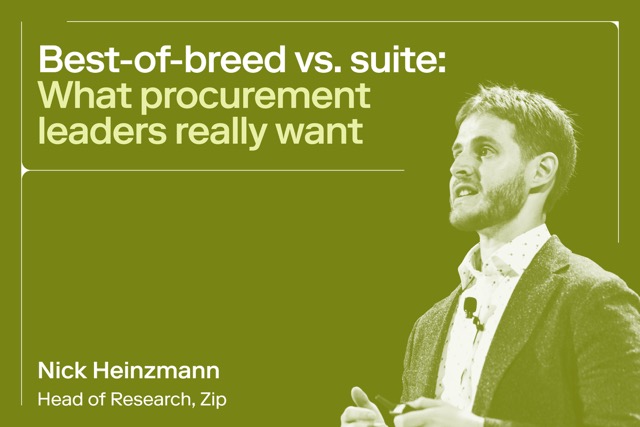
What is centralized purchasing? Definition, tips, and more
Learn how centralized purchasing unlocks cost savings and improves efficiency.

Centralized purchasing sounds simple, right? Just one team handles all the company buying. But managing procurement across an entire organization can feel like herding cats. You've got departments with wildly different needs, suppliers with varying levels of reliability, and budgets that seem to shrink by the minute. It's easy to feel like you're constantly putting out fires instead of strategically managing your spend.
But centralized purchasing, when done right, can be your secret weapon. By consolidating buying power and streamlining processes, you can gain control, cut costs, and ultimately make your life (and meeting your company's bottom line) a whole lot easier.
In this guide, we'll break down exactly what centralized purchasing is, how it works, and how you can implement it effectively without getting lost in the chaos.
What is centralized purchasing?
Centralized purchasing consolidates all your company's buying activity into a single, dedicated department or team. Instead of each department or individual going rogue and buying whatever they think they need, all purchase requests flow through this central hub. This allows for better control over spending, improved negotiation power with suppliers, more efficient contract management, and a consistent, streamlined procurement process.
Now, we know what you're thinking: "Does that mean more red tape?" And yes, sometimes it can feel that way. But the reality is, when done right, centralized purchasing actually simplifies things. It brings clarity to the often murky world of procurement, allowing you to see where your money's going, identify areas for savings, and build stronger relationships with key suppliers.
Plus, by standardizing processes and leveraging technology, you can automate tedious tasks, freeing up your team to focus on more strategic initiatives.
How does centralized purchasing work?

Centralized purchasing is a structured process that brings clarity and control to your spending. Let's walk through the key steps involved, from identifying needs to managing supplier relationships, and see how this approach can transform your procurement process.
1. Needs identification and consolidation
Instead of scattered requests, departments submit their needs to the central team, who then bundle similar items. This allows for a bird's-eye view of what’s actually needed and sets the stage for smarter bulk buying.
2. Supplier selection and relationship management
Now comes the strategic part. The central procurement team researches and selects suppliers based on price, quality, and reliability. They negotiate contracts, build those crucial relationships, and become the go-to experts for all things supplier-related.
3. Purchase order processing
Once a supplier's locked in, the central team issues clear, detailed purchase orders, outlining exactly what’s needed and when. This step is about getting the paperwork right, avoiding those costly "oops" moments down the line.
4. Order fulfillment and delivery
Then comes the actual delivery. Departments receive their goods, and the procurement team verifies that everything’s as expected. This step ensures that what you ordered is what you received and that it arrived on time.
5. Invoice processing and payment
Invoices roll in, and the AP department (or invoice automation) matches them against the original POs and delivery documents. This ensures accuracy so payments are processed smoothly and on time.
6. Contract management
Centralized procurement teams don’t just file and forget contracts. They manage renewals, renegotiations, and performance reviews. This ensures your business is always getting the best deal and staying on top of compliance.
7. Technology integration
Trying to manage all this manually can be a juggling act. That’s where technology steps in. Modern centralized purchasing increasingly relies on procurement software and ERP systems to automate tasks, improve efficiency, and give you a clear, real-time view of the entire process.
Benefits and drawbacks of centralized purchasing
Like any business strategy, centralized purchasing isn't a one-size-fits-all solution. While it offers a slew of benefits, it's also important to acknowledge the potential drawbacks. The key is to weigh these pros and cons against your organization's specific needs and structure.
Understanding both sides of the coin can help you determine if centralized purchasing is the right fit and, if so, how to implement it effectively.
Benefits of centralized purchasing
Centralized purchasing shines when it comes to efficiency and cost control. By consolidating buying power, you can negotiate better prices, reduce redundant spending, and gain a clear view of where your money is going. Here's a quick rundown:
- Cost savings: Centralized purchasing allows for bulk discounts, fewer duplicate orders, and a clearer picture of where your cash is flowing. It’s easier to get more bang for your buck by buying smarter and cutting out the waste.
- Increased negotiation power: When you're buying in volume, suppliers listen. Suddenly, you've got the leverage to negotiate better prices and terms.
- Improved spend visibility: Centralized purchasing sheds light on where your money is going. With clear tracking and analysis, you can pinpoint areas for improvement and make smarter decisions.
- Enhanced compliance: Centralized purchasing makes it easier to stay on the right side of things by ensuring all purchases adhere to company policies and legal requirements, reducing the risk of costly mistakes.
- Standardized processes: Streamlined workflows and fewer errors mean things run smoother. Centralized purchasing brings consistency to your procurement, making everyone's life a little easier.
- Stronger supplier relationships: It's about building partnerships, not just transactions. Centralized procurement allows you to develop solid relationships with key suppliers, leading to long-term value and reliability.
Drawbacks of centralized purchasing
Of course, no system is perfect. Centralized purchasing can introduce its own set of challenges, particularly around flexibility and control:
- Potential for bureaucracy: All that centralized control can sometimes lead to slower decision-making. It adds a few extra layers of approval, which, while meant to be thorough, can also feel a bit sluggish.
- Reduced flexibility: Departments might find themselves with less wiggle room to make their own purchasing decisions. They may need to trade some autonomy for overall efficiency.
- Potentially slower response times: When urgent or specialized purchases need to be made, the centralized process might take a bit longer. It's a trade-off for the standardized approach.
- Potential for departmental resistance: Some teams might feel like they're losing control, which can lead to a bit of pushback. This is where managing change and communication is paramount.
- Increased central team workload: The central team takes on a lot, handling a higher volume of requests and responsibilities. It's important to make sure they have the resources and support they need.
Centralized purchasing vs. decentralized purchasing vs. hybrid purchasing
.webp)
Many organizations operate under different purchasing models based on their business requirements, like a decentralized purchasing model or a hybrid system.
Decentralized purchasing distributes the purchasing function across different departments or locations within an organization, allowing for more localized decision-making and potentially quicker responses to departmental needs. Basically, it’s the opposite of centralized purchasing, where everything flows through one team.
Decentralization works best when you're spread out, have wildly different needs, or just need to move fast and don't want to wait on a central team. If you're a big, sprawling company with lots of unique needs and you value speed, decentralized procurement might be a better fit for you.
Hybrid purchasing combines elements of both centralized and decentralized models, seeking a balance that leverages the advantages of both approaches. Unlike purely centralized purchasing, where everything goes through one channel, hybrid allows for strategic delegation.
Think of it as a "best of both worlds" approach, ideal for organizations that need the cost savings and control of centralized purchasing for key items but also need the speed and flexibility of decentralized purchasing for specific departmental needs or smaller, routine purchases.
At the end of the day, picking the right purchasing model is all about what your company needs most. No matter which path you choose—centralized, decentralized, or hybrid—you can set yourself up for success. Just make sure you have a clear purchasing policy in place to guide everyone toward smart and efficient buying decisions. It's about giving your team the tools they need to succeed, no matter how you decide to structure things.
How to successfully implement centralized procurement
Implementing a centralized purchasing strategy isn’t always easy, but the process doesn’t need to be an uphill battle. With a strategic approach and careful planning, you can set yourself up for success. Let's walk through the key steps to get started.
Evaluate your current processes
Before you dive headfirst into a new procurement system, take a good look at what you're already doing. What's working? What's not? Where are the bottlenecks and pain points? Understanding your current procurement landscape will help you pinpoint areas for improvement and tailor your centralized purchasing strategy to your specific needs.
Think about how you're currently handling purchase requests, who's involved in the approval process, and how you're tracking spending. Are you relying on spreadsheets and emails, or do you have procurement software in place? By identifying the strengths and weaknesses of your current system, you can build a centralized approach that truly streamlines your operations and addresses your unique challenges.
Have a goal in mind
Centralized purchasing isn't just about changing how you buy things; it's about achieving specific outcomes. So, what are you hoping to achieve? Do you want to cut costs? Improve efficiency? Gain better control over spending? Having clear goals will guide your implementation and help you measure success down the line.
Think about setting key performance indicators (KPIs) to track your progress. These could include things like cost savings, supplier performance, or the time it takes to process a purchase order. By monitoring these KPIs, you can see what's working and what's not and make adjustments as needed.
Get your stakeholders on board
Centralized purchasing isn't a solo mission. It involves everyone in the company, from individual employees to department heads. To make it work, you need buy-in from all stakeholders. That means clear communication and collaboration are key.
Make sure everyone understands the why behind the change and how it will benefit them and the company as a whole. Address any concerns they might have, and be open to feedback. When everyone's on the same page about procurement management and goals, you're much more likely to have a smooth and successful implementation.
Find the right procurement software
Let's be honest: Trying to manage centralized purchasing manually is like trying to navigate with a paper map in the age of GPS. The right procurement software can make all the difference. It can automate tasks, streamline workflows, and provide valuable insights into your spending. The right software will depend on your unique needs, but here are a few features to look for in a modern centralized procurement system:
- Automated purchase order processing: This feature streamlines purchase order creation, approval, and tracking, reducing manual effort and errors.
- Spend analytics and reporting: Gain valuable insights into your spending patterns, identify cost-saving opportunities, and track KPIs all in one place.
- Supplier management tools: Manage supplier information, track performance, and collaborate more effectively with vendors.
- Contract management features: Store, track, and manage all your contracts in one central location, ensuring compliance and reducing risk.
- Integration with your ERP or accounting system: Seamlessly connect your procurement software with your existing systems for a more efficient and integrated workflow.
Improve your purchasing process with Zip automation
Centralized purchasing is a powerful strategy for organizations looking to streamline their procurement process, enhance efficiency, and save money. But getting it up and running often is easier said than done.
That’s where the right tools can make all the difference.
Cutting-edge platforms with AI-powered capabilities like Zip can take the headache out of centralized procurement. It's like having a personal assistant for your procurement team. You can set clear spending controls, automate approvals, and get a clear view of your entire process. Plus, Zip's AI-powered invoice processing accelerates invoice processing time by 50%, cutting down on manual work and freeing up your team to focus on the bigger picture.
Ready to see how Zip can transform your procurement? Request a demo today.

Maximize the ROI of your business spend

Enter your business email to keep reading



























.webp)



















.avif)













.avif)










.webp)





.avif)












.avif)
